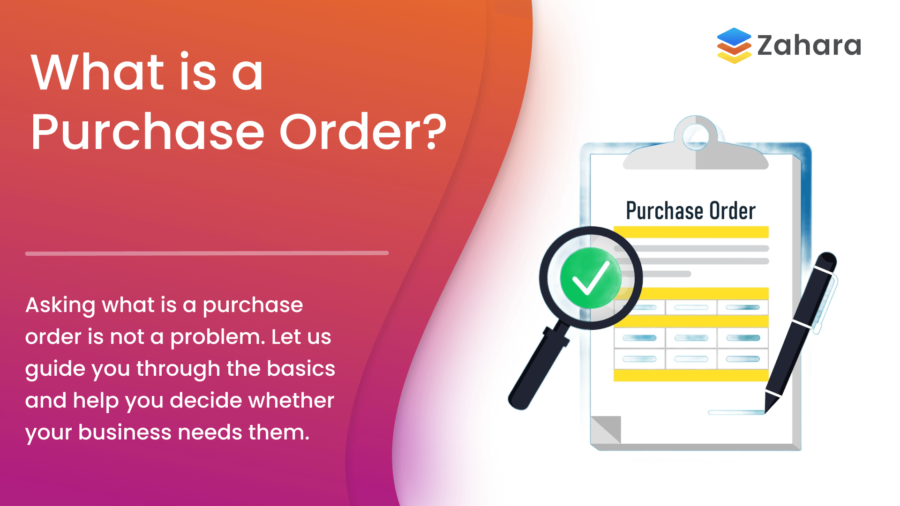A purchase order (PO) is a formal document sent by a buyer to a supplier. It confirms an order for goods or services, stating quantities, prices, delivery dates, and payment terms.
Table of Contents
Once accepted, a PO becomes a binding agreement.
POs help track spending, avoid disputes, and keep procurement organised.
Why Use a Purchase Order?
Purchase orders offer control and visibility over spending and create a clear paper trail for buyers and suppliers.
Benefits for buyers:
- Know exactly what’s been ordered and approved
- Manage budgets and committed spend
- Ensure suppliers deliver on agreed terms
Benefits for suppliers:
- Clear instructions on quantities and delivery
- Confidence in getting paid
- Easier order fulfilment with standardised formats
How the Purchase Order Process Works
Here’s a simple PO workflow:
- The buyer identifies a need for goods or services.
- A purchase requisition is created and approved internally.
- A formal PO is sent to the supplier.
- The supplier accepts or rejects the PO.
- Goods or services are delivered.
- The supplier issues an invoice referencing the PO.
- The buyer matches the invoice with the PO and approves it for payment.
Zahara automates this entire process, giving teams a single place to create, approve, and track POs.
Learn more about Zahara’s purchase order software
When Should You Use a Purchase Order?
Use a PO when:
- You want to control spend before placing an order.
- Suppliers need formal documentation to fulfil requests.
- Your team needs visibility over upcoming costs.
- You’re buying large volumes or placing recurring orders.
Some online-only vendors may not accept POs. In these cases, you may not need one.
What Should a Purchase Order Include?
A strong PO contains:
- A unique PO number
- Order date and delivery date
- Buyer and supplier details
- Delivery address
- Currency and pricing
- Product descriptions and SKUs
- Quantities ordered
- Unit costs and total costs
- Tax details
- Payment terms
- Any relevant legal terms or conditions
Zahara’s PO templates include all these fields. You can also link your full terms and conditions online.
Types of Purchase Orders
Different situations call for different PO types.
Standard Purchase Order
For one-off, single transactions.
Blanket Purchase Order
For ongoing purchases over time, often with volume discounts.
Standing Purchase Order
For regular deliveries under one PO reference.
Zahara makes it easy to create and manage all these types.
Preferred PO Formats: PDF, CSV, or JSON?
Suppliers often have format preferences. Zahara supports:
- PDF: Simple and clear for standard orders.
- CSV: Ideal for bulk item orders.
- JSON: Best for automated, system-to-system integrations.
Always ask your suppliers which format they prefer. This helps reduce delays and errors.
Managing Terms and Conditions
Your PO should clearly state payment terms. These may differ from your supplier’s invoice terms.
Example:
Your PO says “Net 30 Days,” but the supplier’s invoice says “Immediate Payment.”
Who wins?
Typically, the party who sets clear terms first.
That’s why Zahara’s templates allow you to link to your standard company terms automatically.
Tips for Creating Better Purchase Orders
- Use supplier-specific product codes.
- Be clear about unit types (box, litre, etc.).
- State the currency.
- Define payment terms upfront.
- Keep the layout clean and legible.
- Include CSV attachments for multi-line orders.
- Ensure only authorised team members send POs.
How POs Support Invoice Automation
POs aren’t just for ordering—they streamline invoice processing too.
Zahara links purchase orders, goods received, and supplier invoices.
This lets you automate approvals and cut manual data entry.
Learn more about invoice processing with Zahara
Manual POs vs Zahara’s Automated Purchase Orders
Here’s how Zahara’s automated process compares to doing things manually:
Automation saves time, reduces costs, and improves accuracy.
| Manual Process | Zahara Automated Process | |
|---|---|---|
| Time | Slow and admin-heavy | Fast and streamlined |
| Accuracy | Error-prone | Error-free |
| Cost | Higher due to admin time | Lower with automation |
PO vs Invoice: What’s the Difference?
| Feature | Purchase Order | Invoice |
|---|---|---|
| Purpose | Request for goods/services | Request for payment |
| Created by | Buyer | Supplier |
| Sent to | Supplier | Buyer |
| Timing | Before goods are supplied | After goods are supplied |
POs come first. Invoices come after.
FAQs About Purchase Orders
Yes. Once a supplier accepts it, the PO acts as a contract.
No. Online-only suppliers may not need one.
Yes. Zahara supports PDF, CSV, and JSON formats.
Final Thoughts on What Is a Purchase Order?
Purchase orders help buyers control spend and give suppliers clarity on what to deliver.
They also form the foundation for faster, more accurate invoice processing.
Zahara makes it simple to automate your PO process—from request to payment approval.
You Might Also Like to Read:
👉 The Importance & Benefits of Purchase Order Approvals
Learn how structured approvals improve control and efficiency.
👉 Do You Have the #1 Best PO System?
Check if your current PO system meets industry standards.
👉 What Does a Healthy PO System Look Like?
Discover the key traits of a strong, reliable PO setup.
👉 Purchase Order Definition (Corporate Finance Institute)
Learn the accounting definition of a purchase order.


